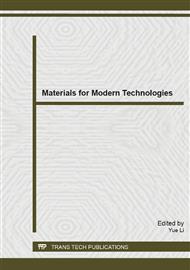[1]
M. Höök and X. Tang, Depletion of fossil fuels and anthropogenic climate change—A review, J. Energy Policy. 52 (2013) 797-809.
DOI: 10.1016/j.enpol.2012.10.046
Google Scholar
[2]
S. Shafiee and E. Topal, An econometrics view of worldwide fossil fuel consumption and the role of US, J. Energy Policy. 36 (2008) 775-786.
DOI: 10.1016/j.enpol.2007.11.002
Google Scholar
[3]
A. Zecca and L. Chiari, Fossil-fuel constraints on global warming, J. Energy Policy, 38 (2010) 1-3.
DOI: 10.1016/j.enpol.2009.06.068
Google Scholar
[4]
X. G. Li, Y. Lv, B. G. Ma, S. W. Jian, and H. B. Tan, Thermogravimetric investigation on co-combustion characteristics of tobacco residue and high-ash anthracite coal, J. Bioresource Technology. 102 (2011) 9783-9787.
DOI: 10.1016/j.biortech.2011.07.117
Google Scholar
[5]
B. D. Bals and B. E. Dale, Developing a model for assessing biomass processing technologies within a local biomass processing depot, J. Bioresource Technology. 106 (2012) 161-169.
DOI: 10.1016/j.biortech.2011.12.024
Google Scholar
[6]
S. Munir, S. S. Daood, W. Nimmo, A. M. Cunliffe, and B. M. Gibbs, Thermal analysis and devolatilization kinetics of cotton stalk, sugar cane bagasse and shea meal under nitrogen and air atmospheres, J. Bioresource Technology. 100 (2009) 1413-1418.
DOI: 10.1016/j.biortech.2008.07.065
Google Scholar
[7]
C. Moon, Y. Sung, S. Ahn, T. Kim, G. Choi, and D. Kim, Effect of blending ratio on combustion performance in blends of biomass and coals of different ranks, J. Experimental Thermal and Fluid Science. 47 (2013) 232-240.
DOI: 10.1016/j.expthermflusci.2013.01.019
Google Scholar
[8]
M. V. Gil, D. Casal, C. Pevida, J. J. Pis, and F. Rubiera, Thermal behaviour and kinetics of coal/biomass blends during co-combustion, J. Bioresource Technology. 101 (2010) 5601-5608.
DOI: 10.1016/j.biortech.2010.02.008
Google Scholar
[9]
C. Branca, C. Di Blasi, and C. Russo, Devolatilization in the temperature range 300–600K of liquids derived from wood pyrolysis and gasification, J. Fuel, 84 (2005) 37-45.
DOI: 10.1016/j.fuel.2004.07.007
Google Scholar
[10]
L. Li, X. Yin, C. Wu, L. Ma, and Z. Zhaoqiu, Kinetic Studies On The Pyrolysis and Combustion of Bio-oil, in ISES Solar World Congress 2007: Solar Energy and Human Settlement, (2007).
DOI: 10.1007/978-3-540-75997-3_483
Google Scholar
[11]
Q. Lu, W. -Z. Li, and X. -F. Zhu, Overview of fuel properties of biomass fast pyrolysis oils, J. Energy Conversion and Management. 50 (2009) 1376-1383.
DOI: 10.1016/j.enconman.2009.01.001
Google Scholar
[12]
M. Muthuraman, T. Namioka, and K. Yoshikawa, Characteristics of co-combustion and kinetic study on hydrothermally treated municipal solid waste with different rank coals: A thermogravimetric analysis, J. Applied Energy. 87 (2010) 141-148.
DOI: 10.1016/j.apenergy.2009.08.004
Google Scholar
[13]
Í. Yakar Elbeylí and Pískìn, Pyrolysis Kinetics of Turkish Bituminous Coals by Thermal Analysis, Turkish Journal of Engineering and Environmental Science. 28 (2004) 233-239.
Google Scholar
[14]
C. Moon, Y. Sung, S. Ahn, T. Kim, G. Choi, and D. Kim, Thermochemical and combustion behaviors of coals of different ranks and their blends for pulverized-coal combustion, J. Applied Thermal Engineering. 54 (2013) 111-119.
DOI: 10.1016/j.applthermaleng.2013.01.009
Google Scholar
[15]
S. Wang, Y. Tang, H. H. Schobert, G. D. Mitchell, F. Liao, and Z. Liu, A thermal behavior study of Chinese coals with high hydrogen content, International Journal of Coal Geology. 81 (2010) 37-44.
DOI: 10.1016/j.coal.2009.10.012
Google Scholar
[16]
P. Pimenidou and V. Dupont, Characterisation of palm empty fruit bunch (PEFB) and pinewood bio-oils and kinetics of their thermal degradation, J. Bioresource Technology. 109 (2012) 198-205.
DOI: 10.1016/j.biortech.2012.01.020
Google Scholar
[17]
X. Ren, J. Meng, A. M. Moore, J. Chang, J. Gou, and S. Park, Thermogravimetric investigation on the degradation properties and combustion performance of bio-oils, J. Bioresource Technology. 152 (2014) 267-274.
DOI: 10.1016/j.biortech.2013.11.028
Google Scholar
[18]
V. Volli and R. K. Singh, Production of bio-oil from de-oiled cakes by thermal pyrolysis, J. Fuel. 96 (2012) 579-585.
DOI: 10.1016/j.fuel.2012.01.016
Google Scholar
[19]
E. Biagini, F. Lippi, L. Petarca, and L. Tognotti, Devolatilization rate of biomasses and coal–biomass blends: an experimental investigation, J. Fuel, 81 (2002) 1041-1050.
DOI: 10.1016/s0016-2361(01)00204-6
Google Scholar
[20]
H. B. Vuthaluru, Investigations into the pyrolytic behaviour of coal/biomass blends using thermogravimetric analysis, J. Bioresource Technology. 92 (2004) 187-195.
DOI: 10.1016/j.biortech.2003.08.008
Google Scholar
[21]
C. Meesri and B. Moghtaderi, Lack of synergetic effects in the pyrolytic characteristics of woody biomass/coal blends under low and high heating rate regimes, J. Biomass and Bioenergy. 23 (2002) 55-66.
DOI: 10.1016/s0961-9534(02)00034-x
Google Scholar


